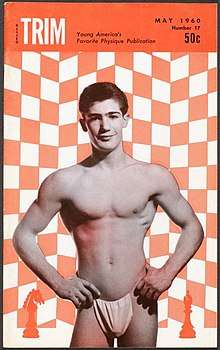Beefcake magazine
Beefcake or physique magazines feature photographs of "beefcake": muscular men – typically young and attractive – in athletic poses, usually in revealing, minimal clothing. During their heyday in North America in the 1940s to 1960s, they were commonly presented as magazines dedicated to fitness, health, and bodybuilding, with the models often shown demonstrating exercises or the results of their regimens, or as artistic reference material. However, their unstated primary purpose was erotic imagery, for gay and bisexual men and straight women, skirting mid-20th-century censorship laws which prohibited depiction of full nudity, and cultural taboos against homosexuality.

Unlike overt gay pornography, beefcake magazines could be sold by newspaper stands, bookstores, and pharmacies – where they could be purchased by closeted gay and bisexual men under the pretense of an interest in fitness or figurative art – and could be sent through the U.S. mail. They were available in cities and even towns across the United States and by subscription, and popular titles such as Physique Pictorial served as an early nationwide cultural nexus for bisexual and gay men.
With the legalization and increased availability of gay pornographic magazines and videos in the 1960s and 1970s, most beefcake magazines either evolved to include more explicit material or went out of business. They experienced a smaller resurgence in popularity with a greater focus on fitness in the 1980s and 1990s alongside fitness magazines for a more heterosexual audience, before the decline of the magazine industry in general.
History
United States
In December 1945, gay pornography pioneer Bob Mizer founded the Athletic Model Guild. Mizer's AMG produced Physique Pictorial, the first all-nude and all-male magazine, and the film Beefcake documents his work and the growth of the Beefcake magazine industry. H. Lynn Womack published magazines such as Manorama, MANual, Fizeek, and Trim and was involved in the U.S. Supreme Court case MANual Enterprises v. Day (1962). From 1964 to 1967, Clark Polak published DRUM magazine.
In the 1960s, the pretense of being about exercise and fitness was dropped as controls on pornography were reduced. By the end of the decade gay pornography became legal, and the market for beefcake magazines collapsed.
Young Physique magazine was a prime example of this genre. It had a centerfold with a young model wearing a posing strap (g-string) with creative sets designed by the well-known gay photographer James Bidgood. Showing total nudity was illegal in much of the United States before 1962, so all models had to wear posing straps.[1]
In the 1980s and 1990s, beefcake magazines enjoyed a resurgence due to a heightened interest in gym culture as well as the onset of the AIDS epidemic. Numerous titles found success, such as Men's Workout, Exercise for Men Only, and Men's Exercise. These magazines are highly visual-oriented with extensive pictorials in contrast to fitness magazines that focus more on text such as Men's Fitness. Many of the images feature homoerotic or suggestive sexual imagery, such as male models unbuttoning their pants or almost full nudity. Some have included profiles of male strippers and some of the male models have also appeared in Playgirl.
Canada
Muscle & Fitness was founded by bodybuilder Joe Weider several years before Physique Pictorial began publication.[2]
United Kingdom
Superman, one of the first British male physique magazines, was published from the 1930s into the early 1940s.[2]
Vigour was published from 1946 to 1955, numbering 115 issues, and was resurrected in 2013 as a general fitness, health, nutrition, and adventure publication.[3]
British physique photographer John S. Barrington launched Male Model Monthly, featuring models with Greek or Roman statuary.[2]
U.S. Male featured models photographed by Bob Mizer in the mid 1960s.[2]
Magazines
- Full-size magazines
- Beach Adonis
- Demi-Gods
- Face and Physique
- Mr. America
- Muscle Boy
- Muscles a Go-Go
- Teen Torso
- Tomorrow's Man Special
- Young Physique (US, 1958 - 1968)
- Pocket-size magazines
- Adonis
- Art and Physique
- Body Beautiful
- Fizeek Art Quarterly[4]
- Grecian Guild Pictorial
- Male Figure
- Male Pix
- Man Alive
- Manorama
- MANual
- Man's World
- Mars
- Muscle Teens
- 101 Boys Art
- Physique Illustrated
- Physique Artistry
- Physique Pictorial
- Scan
- Tomorrow's Man
- Trim
- Vim
See also
- List of gay pornographic magazines
- Tom of Finland
- Bara (genre)
References
- The United States Supreme Court ruled that nude male photographs were not obscene in MANual Enterprises v. Day, 370 U.S. 478 in 1962. A number of softcore gay pornographic magazines featuring fully nude models, some of them tumescent, quickly appeared. See: Barron, Jerome A. and Dienes, C. Thomas, First Amendment Law, St. Paul, Minn.: West Publishing Co., 1993, ISBN 0-314-02581-2 ; Streitmatter, Rodger and Watson, John C., "Herman Lynn Womack: Pornographer as First Amendment Pioneer," Journalism History, 28:56 (Summer 2002); and Waugh, Thomas, Hard to Imagine: Gay Male Eroticism in Photography and Film from Their Beginnings to Stonewall, New York: Columbia University Press, 1996, ISBN 0-231-09998-3 .
- Mizer, Bob (2016-12-27). "Beefcake From Across the Pond, Part III: From Muscle & Fitness to Barrington's Boys". Bob Mizer Foundation. Retrieved 2020-02-06.
- Mizer, Bob (2016-12-14). "Beefcake from across the pond: The male physique in Britain, part I". Bob Mizer Foundation. Retrieved 2020-02-06.
- Fizeek Art Quarterly: Archived July 29, 2009, at the Wayback Machine